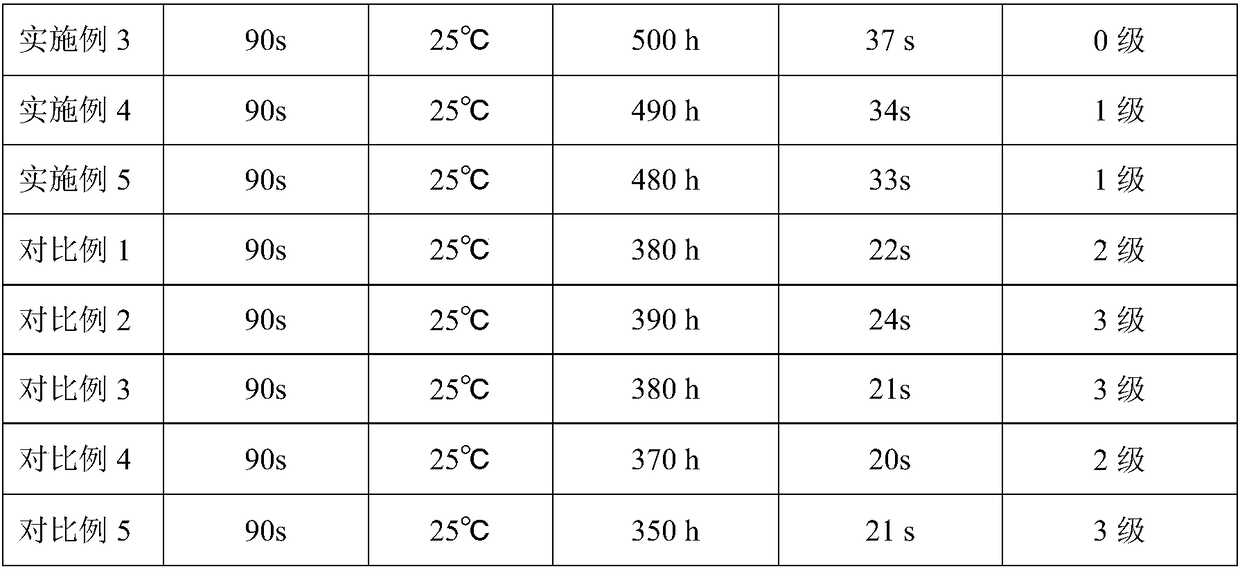Metal surface silane treatment agent and preparation method thereof
A technology of silane treatment agent and metal surface, which is applied in the direction of coating, anti-corrosion coating, etc., can solve the problems of uneven film formation of silanization treatment agent, poor adhesion of film coating, weak corrosion resistance, etc., and achieve film formation Good effect, strong coating adhesion and strong corrosion resistance
- Summary
- Abstract
- Description
- Claims
- Application Information
AI Technical Summary
Problems solved by technology
Method used
Image
Examples
Embodiment 1
[0050] Weigh the following raw materials in parts by weight: Component A: 4 parts of γ-aminopropyl triethoxysilane, 1 part of γ-glycidyl etheroxypropyl trimethoxysilane, 1 part of γ-chloropropyl triethoxy 0.2 parts of silane, 0.4 parts of methyltriethoxysilane, 0.1 part of benzotriazole, 6 parts of polyol, 1 part of methanol, 90 parts of water; component B: γ-aminopropyltriethoxysilane 12 Parts, 0.2 parts of γ-chloropropyl triethoxysilane, 0.2 parts of N-(β-aminoethyl)-γ-aminopropyl triethoxysilane, 10 parts of polyols, 60 parts of water; standby,
[0051] Prepare as follows:
[0052] (1) Preparation of component A: first weigh γ-aminopropyltriethoxysilane, γ-glycidyl etheroxypropyltrimethoxysilane, γ-chloropropyltriethoxysilane, methyl Add triethoxysilane into water and stir until it is completely hydrolyzed; then add polyols and methanol and stir evenly; finally add benzotriazole and stir until the solution is clear to obtain component A.
[0053] (2) Preparation of compon...
Embodiment 2
[0056]Weigh the following raw materials in parts by weight: Component A: 5 parts of γ-aminopropyl triethoxysilane, 1.5 parts of γ-glycidyl etheroxypropyl trimethoxysilane, γ-chloropropyl triethoxy 0.3 parts of silane, 0.6 parts of methyltriethoxysilane, 0.15 parts of benzotriazole, 7 parts of polyol, 95 parts of water; component B: 13 parts of γ-aminopropyl triethoxysilane, γ- 0.3 parts of chloropropyl triethoxysilane, 0.3 parts of N-(β-aminoethyl)-γ-aminopropyl triethoxysilane, 11 parts of polyols, 65 parts of water; spare,
[0057] The preparation method is the same as in Example 1.
[0058] When using, mix component A and component B according to the weight ratio of 1:0.9, and then use it.
Embodiment 3
[0060] Weigh the following raw materials in parts by weight: Component A: 7 parts of γ-aminopropyl triethoxysilane, 2 parts of γ-glycidyl etheroxypropyl trimethoxysilane, γ-chloropropyl triethoxy 0.5 parts of silane, 0.8 parts of methyltriethoxysilane, 0.2 parts of benzotriazole, 9 parts of polyols, 2 parts of methanol, 100 parts of water; component B: 15 parts of γ-aminopropyltriethoxysilane , 0.5 parts of γ-chloropropyl triethoxysilane, 0.5 parts of N-(β-aminoethyl)-γ-aminopropyl triethoxysilane, 13.5 parts of polyol, 2 methanol, 70 parts of water; spare ,
[0061] The preparation method is the same as in Example 1.
[0062] When using, mix component A and component B according to the weight ratio of 1:1, and then use it.
PUM
 Login to View More
Login to View More Abstract
Description
Claims
Application Information
 Login to View More
Login to View More - R&D
- Intellectual Property
- Life Sciences
- Materials
- Tech Scout
- Unparalleled Data Quality
- Higher Quality Content
- 60% Fewer Hallucinations
Browse by: Latest US Patents, China's latest patents, Technical Efficacy Thesaurus, Application Domain, Technology Topic, Popular Technical Reports.
© 2025 PatSnap. All rights reserved.Legal|Privacy policy|Modern Slavery Act Transparency Statement|Sitemap|About US| Contact US: help@patsnap.com


